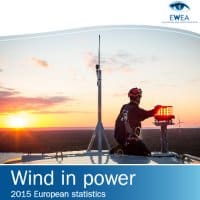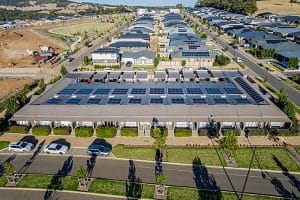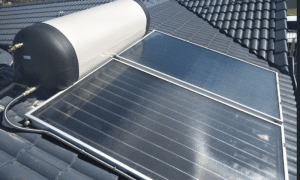Nearly half of all Europe’s power generation capacity installed last year were new wind energy projects according to a report from the European Wind Energy Association (EWEA).
EWEA’s analysis of 2015 shows wind power accounted for 44.2 percent of total capacity added across the 28 EU member states, an increase of 6.3 percent on 2014 installations.
12,800 MW of new wind capacity was connected to EU grids last year – split between 9,766 MW onshore capacity and 3,034 MW offshore. This meant wind was the energy technology with the highest rate of installation in 2015. Solar PV came in second with 8,500 MW, or 29 percent of 2015 installations.
Total European wind capacity now stands at 142 GW and meets 11.4 percent of the continent’s electricity needs.
In a significant indicator of wind’s success, the report shows wind power has overtaken hydro as the third largest source of electricity generation in the EU, with a 15.6 percent share of total output capacity.
EU member states have been decommissioning more coal and oil-fired generation capacity than they install, and this trend continued in 2015. 4.7 GW of coal fired power generation was built vs. 8 GW decommissioned, while new few oil capacity was zero. By contrast, renewable energy made up 77 percent of new power installations – 22.3 GW of a total 29 GW.
“These numbers show that wind is the driving force behind the EU’s energy transition. Wind energy is a mature industry,” said Giles Dickson, Chief Executive Officer of the European Wind Energy Association. ” It makes economic sense and is contributing significantly to Europe’s energy security and competitiveness goals.”
Investments in both onshore and offshore wind farms reached record levels last year, increasing 40 percent over 2014 numbers, to €26.4 billion. Germany lead the EU for newly installed wind capacity in 2015, adding 6 GW in 2015. Poland came in second place with 1.2 GW, followed closely by France and the UK, which installed 1.07 GW and 975 MW respectively.
Several factors accounted for the level of new wind additions, according to EWEA’s analysis: Germany’s effective wind power policies, the connection of large amounts of offshore capacity installed but not grid-connected in 2014, and a rush to complete installations before Germany moves to market-based arrangements in 2017.
“We’ve seen strong expansion in Germany in 2015 and a strong year for offshore wind. But growth is uneven geographically. We’re not doing as well in countries where the policy and regulation is unclear and/or ineffective – investors and developers go elsewhere,” Dickson said.
“Policy is key, especially when we look at the longer term. As of now only 6 out of the 28 EU states have clear targets and policies in place for renewables post-2020. We see more ambition in emerging economies – which puts a question mark by the EU’s goal to be No. 1 in renewables.
The Wind In Power report can be viewed in full here (PDF).







































